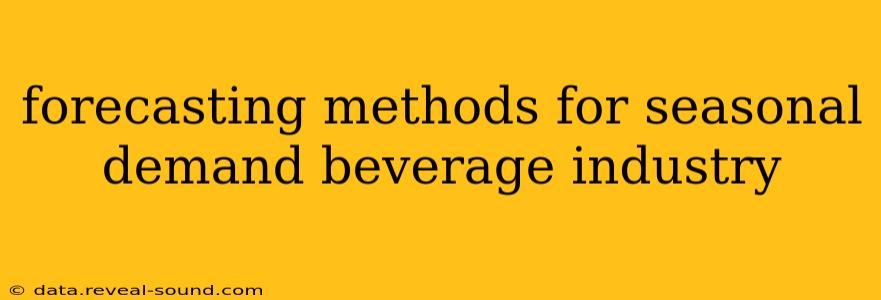The beverage industry, encompassing everything from soft drinks and juices to alcoholic beverages and bottled water, is heavily influenced by seasonal trends. Accurately forecasting seasonal demand is crucial for effective inventory management, production planning, marketing campaigns, and overall profitability. This article explores various forecasting methods specifically tailored for the unique challenges of seasonal beverage demand.
What are the common seasonal patterns in the beverage industry?
Seasonal demand in the beverage industry varies greatly depending on the specific product. However, some common patterns emerge:
- Increased demand during warmer months: Soft drinks, juices, iced teas, and alcoholic beverages like beer and cider often experience peak sales during summer and spring, driven by increased outdoor activities and warmer temperatures.
- Holiday-specific surges: Certain beverages see spikes around specific holidays. For example, sparkling wine and champagne sales peak around New Year's Eve and Christmas, while pumpkin spice-flavored drinks are popular during the fall.
- Regional variations: Seasonal patterns can significantly differ based on geographic location. For example, hot chocolate demand will be higher in colder climates during winter.
Understanding these specific seasonal patterns for your particular beverage product is the first step in accurate forecasting.
What forecasting methods are best for seasonal beverage demand?
Several quantitative and qualitative methods can effectively forecast seasonal beverage demand. The optimal approach depends on factors like data availability, budget, and the desired level of accuracy.
1. Time Series Analysis:
This statistical method analyzes historical sales data to identify patterns and trends. It's particularly effective for capturing seasonal fluctuations. Specific techniques within time series analysis include:
- Simple Moving Average: Useful for smoothing out short-term fluctuations and identifying underlying trends. However, it doesn't explicitly model seasonality.
- Weighted Moving Average: Similar to the simple moving average but assigns different weights to more recent data points, giving greater importance to recent trends.
- Exponential Smoothing: A sophisticated technique that assigns exponentially decreasing weights to older data, effectively capturing recent trends and seasonality. Variations like Holt-Winters exponential smoothing are specifically designed to handle seasonal data.
- ARIMA (Autoregressive Integrated Moving Average): A powerful technique for complex time series with seasonality and trend. Requires more statistical expertise to implement effectively.
2. Regression Analysis:
This statistical method explores the relationship between sales (dependent variable) and other factors (independent variables) such as temperature, promotional activities, economic indicators, and competitor actions. Regression models can explicitly incorporate seasonal dummy variables to capture the seasonal effect.
3. Qualitative Forecasting Methods:
These methods rely on expert opinions and judgment. They are valuable when historical data is limited or when significant changes in the market are expected.
- Delphi Method: Involves gathering expert opinions through questionnaires and iterative feedback, reaching a consensus forecast.
- Sales Force Composite: Combines sales representatives' forecasts, leveraging their local market knowledge.
- Market Research: Conducting surveys and focus groups to understand consumer preferences and purchasing intentions.
How can I improve the accuracy of my seasonal beverage demand forecasts?
Several strategies can enhance forecasting accuracy:
- Data Quality: Ensure accurate and reliable historical sales data. Clean and preprocess the data to remove outliers and errors.
- Feature Engineering: Carefully select and engineer relevant independent variables for regression analysis, such as weather data, marketing spend, and competitor actions.
- Model Selection: Choose the appropriate forecasting method based on data characteristics and available resources. Experiment with different methods and compare their accuracy.
- Regular Monitoring and Evaluation: Continuously monitor the forecast's accuracy and make adjustments as needed. Track forecasting errors and identify potential improvements.
- Consider External Factors: Incorporate external factors like economic downturns, natural disasters, and changes in consumer preferences into your forecasts.
What are some common challenges in forecasting seasonal beverage demand?
Several challenges can complicate accurate forecasting:
- Unexpected events: Unforeseen events like extreme weather, economic crises, or significant changes in consumer preferences can significantly impact demand.
- Data limitations: Insufficient historical data, especially for new products or regions, can hinder accurate forecasting.
- Lead times: Production and delivery lead times can affect the effectiveness of demand forecasts.
- Competition: Competitor actions and promotions can influence sales.
How can I use forecasting to improve my inventory management?
Accurate demand forecasting enables:
- Optimized inventory levels: Avoid stockouts during peak demand and minimize excess inventory during low seasons.
- Reduced storage costs: Minimize warehouse space and storage expenses by managing inventory efficiently.
- Improved cash flow: Optimize working capital by avoiding unnecessary investment in inventory.
- Reduced waste: Minimize spoilage and obsolescence through accurate demand predictions.
By employing appropriate forecasting methods and addressing potential challenges, beverage companies can significantly improve their operational efficiency and profitability. Remember that regular evaluation and adaptation are key to maintaining accurate and valuable demand forecasts.
